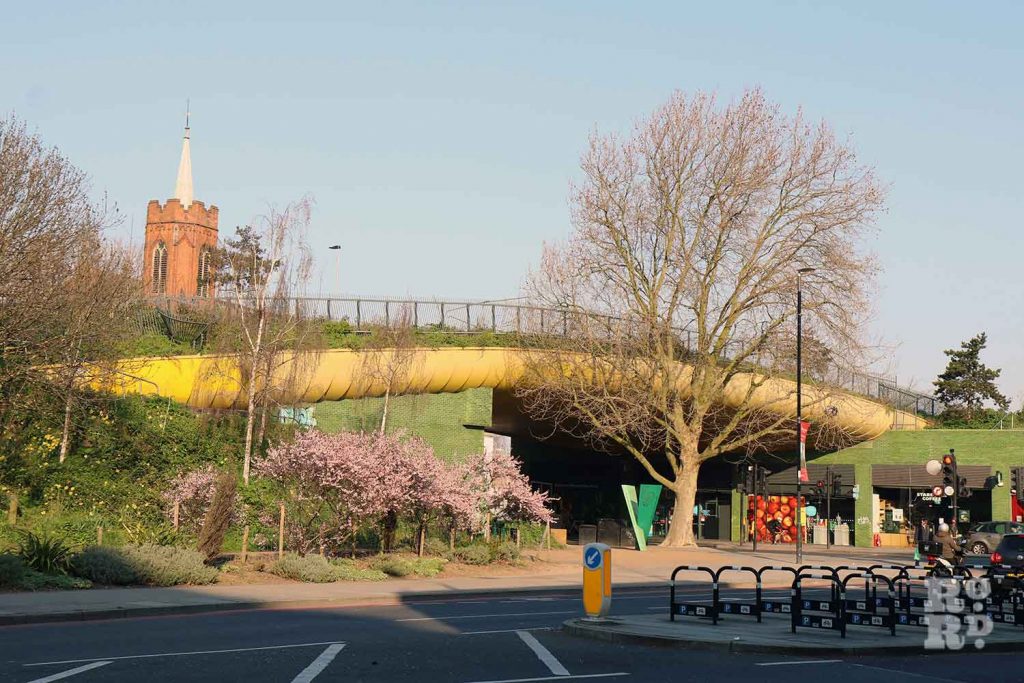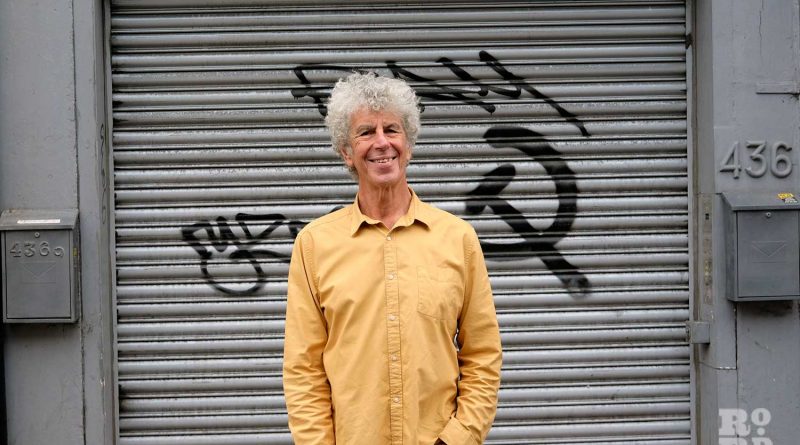Piers Gough CBE: the Bow architect who designed Mile End’s Green Bridge
Architect and Bow resident Piers Gough CBE (74) is best known locally for designing the pedestrian-only, tree-topped Green Bridge, or ‘banana bridge’ as it is fondly referred to, that traverses Mile End Road.
But Gough’s work stretches far beyond Mile End Park, with award-winning architectural feats spanning across the UK as well as being the mastermind behind Janet Street Porter’s house in Clerkenwell since listed for being an ‘extrovert and ostentatious example of post-modern domestic architecture’. We spoke to Gough about how the Green Bridge came to be, where he draws artistic information from and his 45 years living in Bow.
Gough and his architectural firm CZWG that he established in 1975 have designed – amongst many others – the Maggie’s Cancer Care centre in Nottingham and presenter Janet Street-Porter’s house in Clerkenwell, which is now a Grade II-listed building. Gough was even appointed a CBE by the Queen in 1998.
Jovial, witty, and incredibly friendly, Gough explains unassumingly what led him to receive the honour. ‘I did up a whole suite of rooms at the National Portrait Gallery about the regency of Victorian and Modern works, and that was the sort of calling card for the CBE I suppose.’
The Green Bridge, though, arose from much humbler beginnings. In 1995, Gough was invited to a community planning weekend by his friend Jon Aldenton who runs The Environment Trust.
‘We met in the Catholic school behind the church in Mile End park and brainstormed for two days to decide how we were going to transform the space from its rather unused, unloved situation to something much more enjoyable’.
Enjoyable is certainly what the park has become, thanks to that meeting. Alongside local residents, the group collectively mapped out the park’s quirky lakes, humps and bumps and underground grass-covered buildings that now characterise its charm.
But the group needed to think of something unique that would secure funding from the millenium lottery that would really transform the park: ‘We needed something catchy, something that will make them think we’ve got to have that,’ he recalls with his distinctive exuberance.
It was a balmy Sunday afternoon when the idea for the bridge was hatched. Lacking clarity, Gough stepped outside where he had his Isaac Newton moment. ‘I couldn’t think straight, so I went out and lay down in the park, looked at the sky and the idea for the Green Bridge – connecting the two halves of the park together – just popped into my mind.’
When he shared his idea to the rest of the group Jon replied instantly, ‘Yes, that’s it. No argument – to the pub!’
Sure enough, the Lottery said yes straight away, paying £4million for the bridge, and a few more to do up the rest of the park.
A year later and it was built. From Mile End road the bridge appears as a curved yellow structure crowned with trees; drivers would never assume that gleeful bike riders, walkers and sometimes horses are crossing over their heads. On top of the bridge is a very different experience.
‘Even though you’re only about seven metres from the ground, you feel like you’re on top of the world. You can see Canary Wharf, you can see the park – there’s a great feeling of ownership of the East End. You think this is where I belong, this is my place’.
Gough has always been fond of the idea of two public levels in the city, such as the Barbican – one of his favourite buildings. ‘I love the concept of having two public worlds. There’s something wonderful about that separation – of being in a park with the road thundering away underneath you’.
The Green Bridge is not only architecturally pleasing, but serves a public need too. Gough zealously explains: ‘All the shops and restaurants lining the road underneath the structure pay back to Mile End road. The rent from those places also goes into maintaining the park – that was my big idea, it would pay to maintain the park in perpetuity’.
In July 1999, the bridge officially opened – in the most unusual way possible. London Symphony Orchestra musicians beeping their car horns and bicycles with bits of cardboard in their wheels, instructed by their conductor, paraded down Mile End road. ‘The park had won us out over the road, so it was a homage to the road really,’ Gough laughs, ‘it was totally bonkers’.
Twenty-one years later and the bridge’s local legacy is, to Gough, quite simply ‘just a very enjoyable thing to cross’.
Designing things for pleasure, such as the playful Green Bridge, has always been a driving force, sparking his interest in architecture.
Growing up in Brighton, Gough explains how his surroundings made a profound impression: ‘The Royal Pavilion was the most extraordinary extravaganza I’d seen. I thought, is it architecture? Is it scenery? Is it cake? It was a fabulous notion that you could build buildings that were so emotional’.
‘I lived in Brunswick Square, which had this dizzyingly romantic architecture and big bay windows. The whole thing is very blousy and pleasurable, yeah, the architecture of pleasure always intrigued me, I always wanted to do that.’
Gough’s work is not only about pleasure, though. Now living in Bow, he would love to create a public building in the area. ‘I can’t think of any building at the moment that has a great civic presence where a lot of free things happen. It could be overlooking the park, or the canal, or, well – let’s have it all, why not?
Gough moved to Bow in 1975, when an unusual property attracted him to the area – Sylvia Pankhurst’s toy factory just off Roman Road.
Smiling, he reminisces, ‘Of course people used to say “Oh Bow, so you must live in Tredegar Square then?” and I’d say “well, not exactly! I live in the ordinary bit of Bow, in the nice bit, the unposh bit’.
Gough holds very endearing memories while he has been living there. ‘Like everyone else in the world, I adore Victoria Park and, of course, the Pavilion. I made friends with Rob the first day it opened, when it was more of a tea house with very delicate china; it was almost genteel’.
Long before the Pavilion opened in 2011, Vicky Park looked fairly different to how it does today, Gough remembers. ‘There used to be a swimming pool. It wasn’t as big as London Fields’s lido but it had one of those wonderful fountains that aerated water, it kind of squirted out water and flopped down. It was much quieter in the early morning, you could swim for free between 8am – 10am and it would be us and all the OAPs swimming away for nothing – it was really wonderful’.
One of his dearest memories has recently reappeared on the Roman. When Gough first moved in, there were six ‘steam bakeries’ bakeries along the high street where you could buy a loaf at 4am on your way home. ‘It was amazing. What amuses me is that now with Artisan Bakery etc. it’s all come back, the circularity of it! We’ve got all those gorgeous cafes with their amazing breads and pastries, it’s transformative’.
Gough’s architectural creations, in Mile End park and beyond, expertly combine a mix of pleasure and utility, making urban areas that much more enjoyable to live in. The Green Bridge is now embedded within local East End culture and is symbolic of the area’s incredible creative minds who have put their ideas towards improving others’ experience.

Want to uncover more local artists who live in Bow? See Hannah Brown’s peaceful interpretations of Victoria Park.



Thanks for this article: it was great to be reminded that this ever-inspiring fellow architect is still a local resident and that success has not caused him to be drawn to live in a supposedly posher area. I hope he manages to get funding for another public building in the area as he would love to do.
I’m sure I remember Ray Winston writing disparagingly in his book (Young Winston) about this bridge. I respect but totally disagree with him. For one, it is quite kooky and gives you options for getting across the road. It also links the parks. Every time I cycled or walked over it you’d almost pause, or at least slow, at the peak as you took in the views either side. So much more of east London – from Canary Wharf to Stratford would fleetingly come into view. I loved it. I’ve probably crossed it at least hundreds of times. Moved away this year, so wish I could just pop out and walk over it now…